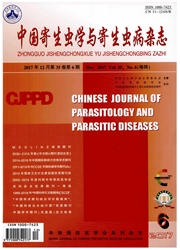

 中文摘要:
中文摘要:
目的动态观察弓形虫速殖子经口感染小鼠诱导IgA分泌细胞(IgASCs)数量和抗体应答水平。方法BALB/c小鼠96只,随机选取12只以PBS灌胃(0.5ml/只),其余小鼠用RH株弓形虫速殖子灌胃(1×104个/只),分别于感染后2、4、6、8、10、12和14d各随机处死12只。免疫组化检测小鼠十二指肠、空肠和回肠黏膜中IgASCs数量,EUSA测定小肠液和血清IgA水平。结果IgASCs分布于小肠黏膜固有层中,不同肠段IgASCs数量的变化规律各异。随感染后时间的推移,十二指肠黏膜IgASCs数量呈上升趋势。感染后2~8d,空肠黏膜的IgASCs数量升高,随后下降,至14d降至感染前水平。回肠黏膜IgASCs数量在感染后2~6d升高,随后下降,12d降至低于感染前水平。感染后小肠液IgA水平持续增高,血清IgA无明显变化。十二指肠、空肠和回肠黏膜的IgASCs数量与小肠液IgA水平的相关性分别为r=0.732(P〈0.01)、r=0.116(P〉0.05)和r=-0.429(P〈0.01)。结论弓形虫速殖子经口感染小鼠可诱导十二指肠IgASCs高水平表达和小肠液IgA水平增高,两者呈正相关。小肠液中高水平的IgA主要由十二指肠黏膜IgASCs分泌。
 英文摘要:
英文摘要:
Objective To investigate the kinetics of IgA secreting cells (IgASCs) in small intestine and the specific antibody level induced by Toxoplasma gondii tachyzoite infection in mice. Methods Ninety-six BALB/c mice were randomly divided into 2 groups, 12 were intragastrically given 0.5 ml PBS as control, the rest were each intragastrically infected with 1×10^4 tachyzoites of the virulent RH strain Toxoplasma gondii. On the day 2, 4, 6, 8, 10, 12, and 14 post infection, 12 mice were sacrificed respectively. The quantity of IgASCs in mucosa of duodenum, jejunum and ileum was detected by immunohistochemistry analysis. IgA in sera and in intestinal washes was determined by ELISA. Results The IgASCs were found in lamina propria of the small intestine mucosa. The amount of IgASCs in duodenal mucosa increased gradually with the time after infection, while in jejunal mucous membrane it increased from the day 2 to 8, and then decreased to the level of before infection on day 14. The amount of IgASCs in ileal mucous membrane also increased from day 2 to 6, then descended gradually and on the day 12 to a level lower than that of before infection. IgA level in the intestinal washes increased continually but there was no significant change in serum samples. The correlation between IgA level in intestinal washes and the quantitative change of IgASCs in mucosa of duodenum, jejunum and ileum was r=0.732 (P〈0.01), r=0.116 (P〉0.05) and r=-0.429 (P〈0.01), respectively. Conclusion Toxoplasma gondii infection induces a high level expression of IgASCs in duodenum and an increase of IgA antibody in the intestinal washes, showing a positive correlation. The high level IgA in the intestinal washes is mainly from IgASCs of the duodenal mucosa.
 同期刊论文项目
同期刊论文项目
 同项目期刊论文
同项目期刊论文
 期刊信息
期刊信息
